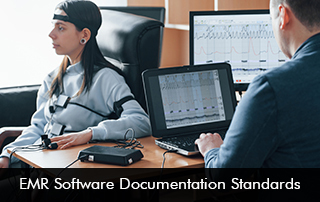Just as there are security standards in Electronic Medical Records (EMR) Software there are also documentation standards. The documentation standards in EHR Software systems help ensure patient data’s accuracy, completeness, and security. Better patient care, regulatory compliance, and more efficient data sharing are made possible by these standards. Uniformity is maintained among various healthcare providers and systems.
Key Documentation Standards in EMR Software Systems
Complete and Accurate Data
Electronic Health Records (EHR) Software should be designed in a way that facilitates structured data entry. Structured data entry formats in EMR systems include checkboxes, standardized templates, and dropdown menus. This helps to reduce errors and improves overall data entry and documentation consistency. Additionally, doctors can be assisted in accurately documenting patient care by the integration of CDS capabilities into EHR Software, such as prompts for missing information.
Integrity, security, and Privacy
It is vital in the United States that the EMR Software is HIPAA Compliant to ensure the 24/7 privacy of patient data. Some robust security features in the software system include access management, audit logs, and user authorization.
Interoperability Standards
Health Level 7 (HL7) and Fast Healthcare Interoperability Resources (FHIR) are critical standards that enable data to be effortlessly transferred between various systems. To ensure interoperability, EHR software should meet these requirements.
Utilizing standardized coding schemes for clinical words (SNOMED), procedures (CPT), and diagnoses (ICD) helps to guarantee that documentation is comprehensible and transportable between various healthcare settings.
Templates and Macros
In-built templates and macros in electronic medical records software simplify tedious clinical documentation processes. However, these tools must be used cautiously to avoid any errors. When providers over-use these features they are at the risk of potential misuse. So there is a fine line between using tools and misusing them.
How have Documentation Standards in EHR Software Evolved?
EMR software documentation standards have changed dramatically over time due to technological breakthroughs, alterations in regulations, and the growing demand for interoperability.
These software systems were first centered on digitizing paper records with the primary goal of effectively storing and retrieving patient data. The adoption of standards such as FHIR and HL7 has allowed for smooth data transfer between different systems throughout time. HIPAA and other regulations have improved privacy and data security measures. Additionally, the accuracy, usefulness, and accessibility of documentation in Electronic Health Records (EHR) Software have increased with the incorporation of patient portals, user-friendly interfaces, and clinical decision support tools.








